Molecular insights into the stability of CO2 hydrate in variable-diameter nano-slit
IF 5.5
0 ENERGY & FUELS
引用次数: 0
Abstract
Most literatures focused on the stability of CO2 hydrate in uniform-diameter nano-slits, while variable-diameter nano-slits may be more prevalent in the realistic environments for CO2 storage processes. This study employs molecular dynamics (MD) simulations to systematically explore the effects of various factors (disordered water, slit size, and wettability) on hydrate stability in variable-diameter nano-slits. It is revealed that the variable-diameter nano-slit affects the activity of disordered water, rather than altering the hydrate crystal structure, to dominate the hydrate stability. The presence of disordered water decreases hydrate stability, with the melting point dropping from 282 K to 269 K when disordered water in large slits, and further declining to 267 K when it in small slits. The Vertical surfaces in the nano-slits induce heterogeneity in disordered water activity, and its proportion dominates the further depression of melting points for hydrates in large slits. The slit surface-water interaction caused by the wettability variation hardly impact the hydrate stability, whereas the differences in nanobubbles distribution significantly influence the stability of hydrates in the small slits. This study firstly offers valuable insights into the complex interactions affecting CO2 hydrate stability in more realistic porous media environments, uncovering the mechanisms by which geometric heterogeneity and interfacial behavior influence hydrate stability.

变直径纳米狭缝中CO2水合物稳定性的分子研究
大多数文献关注的是均匀直径纳米狭缝中CO2水合物的稳定性,而变直径纳米狭缝可能在CO2储存过程的现实环境中更为普遍。本研究采用分子动力学(MD)模拟系统地探讨了各种因素(无序水、狭缝尺寸和润湿性)对变直径纳米狭缝中水合物稳定性的影响。结果表明,变直径纳米狭缝影响了无序水的活性,而不是改变水合物的晶体结构,从而决定了水合物的稳定性。无序水的存在降低了水合物的稳定性,当无序水在大缝中存在时,熔点从282 K下降到269 K,当无序水在小缝中存在时,熔点进一步下降到267 K。纳米裂缝中的垂直表面诱导了无序水活度的非均质性,其比例主导了大裂缝中水合物熔点的进一步降低。由润湿性变化引起的裂隙地表水相互作用对水合物的稳定性影响不大,而纳米气泡分布的差异对小裂隙中水合物的稳定性影响较大。该研究首次揭示了在更现实的多孔介质环境中影响CO2水合物稳定性的复杂相互作用,揭示了几何非均质性和界面行为影响水合物稳定性的机制。
本文章由计算机程序翻译,如有差异,请以英文原文为准。
求助全文
约1分钟内获得全文
求助全文

 求助内容:
求助内容: 应助结果提醒方式:
应助结果提醒方式:


